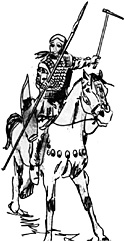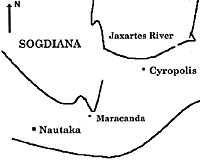This quotation from the Old Testament [1] most certainly describes the Scythian people. These warlike tribes waged war successfully for hundreds of years and merely the mention of their name struck fear in the hearts of their enemies. The Greeks coined the term, "Horse Archers" to describe them. This term is deceiving however, as their ranks contained not only horse archers but cataphracts, peltast and armored infantry as well! Ancient Scythia consisted of the territory between the western portion of the Danube and the eastern portion of the Don rivers. Indeed their territory extended beyond this to the south, Caucasia [2] and far to the east and included the Massagetae and the Dahae people.
Alexander the Great
In 329 B.C., Alexander the Great met with these people and they earned his respect as they had so many before him. Ten years before, Alexander's father Philip, had met the Scythians in combat and defeated them, killing the Scythian King Ateas (he was 90 years old). Alexander must have realized that his normal tactics would prove worthless against what was primarily a mounted enemy and modified his tactics accordingly. Spitamenes [3] led a revolt against Alexander after having first gained favor by turning over Bessus (King Darius' murderer). Joined by Bactrians, Dahae and other Scythians, he would wage a guerrilla war against Alexander for two years!
With small numbers of forces he would lay sieges and use hit and run tactics, literally tying down Alexander's numerically superior army. Spitamenes was the most skilled adversary that Alexander ever faced, except for Memnon. If Spitamenes could have fielded an army that was numerically superior or equal to Alexander's, it is possible that the campaign would have ended quite differently.
Alexander had Craterus lay siege to Cyropolis while sending out his cavalry to the two most distant posts with orders to prevent Spitamenes garrisons from escaping their positions. Alexander personally led the attack against the three nearer forts while the action taken against the other forts is not known.
He took the first fort, Gaza, by storm and had the garrison put to the sword. The other two forts fell as quickly while his cavalry had succeeded in taking the two most distant forts. Returning to Cyropolis, Alexander observed that the river that ran through the city was almost dry.
With a few men he slipped into the city along the river bed and opened the gates allowing full entrance into the city. Eight thousand of the inhabitants were killed and fifteen thousand were captured. Finally, the Macedonians retook the last two forts. Alexander had secured his northern frontier.
Dare
During this period, the Scythians assembled a sizable host commanded by Carthasis, the brother of the Scythian King. His force took position on the opposite bank of the Jaxartes river. Repeatedly they dared Alexander to cross against them, "Just cross the river and you will discover the extent of Scythian territory - but you will never catch the Scythians. With our meager belongings we shall outrun your army with its cargo of booty from so many nations. Then, when you think we are far away, you will see us inside your camp!" [5]
News was also received by Alexander that Spitamenes had laid siege to the 1,000 man Macedonian garrison [6] at Maracanda. Alexander sent Menedemus [7] with 3,000 infantry and 800 cavalry to relieve the siege. Hearing of Menedemus' advance, Spitamenes prepared an ambush in the path at the Polytimetus river where the Macedonian would certainly pass. Menedemus' force was massacred. This distressed Alexander and he gave orders for anyone that divulged what had happened there to be put to death!
Alexander prepared 12,000 rafts [8] to cross the Jaxartes. He covered his crossing with catapults stationed along the bank. When they fired on the Scythian cavalry that were parading the opposite bank, the Scythians were shocked at having one of their numbers struck down at such a distance. One warrior had both shield and breastplate pierced and he fell dead to the ground. [9]
The Scythian host withdrew their line back from the bank at which time Alexander crossed the Jaxartes with his initial forces of light infantry and cavalry.
Exactly what transpired next remains unclear but it appears that after establishing a bridgehead, Alexander sent out a force of Greek mercenary cavalry along with two squadrons of Prodromoi.
Either by design or by error, these troops pursued the Scythian cavalry too far and found themselves out of easy supporting range of their light troops. The Scythians responded with their classic encircling tactic. Round front and rear they discharged their missiles and it appeared that these forces might suffer the same fate as Menedemus.
[10]
Alexander responded by forming up his archers, Agrianians, and other light troops under Balcrus. In addition, he attached three Hipparchies of Companion cavalry to Balcrus' command while he himself led forward his mounted javelinmen and other cavalry. This changed the balance of the engagement into the favor of the Macedonians. The Scythians, unable to ride freely to and fro were compelled to withdraw.
Alexander pursued for some eighty stades but had to give up the chase after becoming seriously ill from having drunk contaminated water. Until this time, most thought the Scythians to be invincible. At least a thousand Scythians were killed in the pursuit and a new delegation was sent to Alexander to discuss peace terms.
Spitamenes continued his fight against Alexander but after several reverses his supporters grew fewer by the day. He was assassinated by his wife after becoming drunk with wine. She then took his head to Alexander and begged for peace!
More Scythians
[1] Jeremiah, 50: 41-2
 Behold, a people shall come from the north, and a great nation, and many kings shall be raised up from the coasts of the earth. They shall hold the bow and the lance: they are cruel and will not show mercy: their voice shall roar like the sea, and they shall ride upon horses, every one put in array, like a man to battle, against thee . . . "
Behold, a people shall come from the north, and a great nation, and many kings shall be raised up from the coasts of the earth. They shall hold the bow and the lance: they are cruel and will not show mercy: their voice shall roar like the sea, and they shall ride upon horses, every one put in array, like a man to battle, against thee . . . "
 There were seven forts along with the city of Cyropolis, which Alexander had garrisoned south of the Jaxartes (Syr Daria) river. These forts were created by Cyrus [4] for protection against the "Barbarians to the North." When Spitamenes and his forces overran these positions, Alexander reacted with his characteristic lightening speed! He knew that unless he reacted quickly and firmly, the Scythian tribes to the north would begin raiding the territories to the south.
There were seven forts along with the city of Cyropolis, which Alexander had garrisoned south of the Jaxartes (Syr Daria) river. These forts were created by Cyrus [4] for protection against the "Barbarians to the North." When Spitamenes and his forces overran these positions, Alexander reacted with his characteristic lightening speed! He knew that unless he reacted quickly and firmly, the Scythian tribes to the north would begin raiding the territories to the south.
NOTES
[2] "The Scythian Road" in the southeast and Dobruja (Scythia Minor) in the west. The northern boundary coincides with modern day Kiev extending south to the Black Sea. Geographers of ancient times described the country as that shape similar to a drawn Scythian bow.
[3] A baron of Sogdiana who led the revolt against Alexander along with Dataphernes and Catanes. They delivered Bessusto Alexander but when summoned by Alexander in 329 they became suspicious of treachery and rebelled.
[4] Cyrus the Great; He defeated Astyages in 559 B.C. and subsequently defeated Croesus, King of Lydia in 548 B.C.. He invaded the kingdom of Assyria and took Babylon and then marched against Tomyris, Queen of the Massagetae (Scythians). He was defeated in battle in 530 B.C.. Queen Tomyris beheaded Cyrus, tossed his head in a container filled with human blood and exclaimed, "Have your fill of the blood for which you thirsted!"
[5] Curtius VII.7.22. Curtius refers to the Jaxartes or Syr Daria as the 'Tanais' river.
[6] Curtius VII.6.10
[7] Curtius states Menedemus commanded this force (VII.6.24) while Arrian makes mention (IV. 4) that Andromachus and Caranus also accompanied with Pharnuces as interpretor.
[8] Curtius. (VII. 8. 7) and (VII. 9. 2-3) "He set in the prows the men equipped with bucklers, having ordered them to kneel to gain better protection against arrows. Behind them stood men to work the slings, covered by armed soldiers on both flanks and in front. The rest stood behind the slings, armed and making a tortoise-formation with their shields to give cover to the oarsmen who wore no protective corselets. This disposition was also preserved on the rafts cartrying the cavalry."
[9] Arrian IV.4
[10] See J.F.C. Fuller, The Generalship of Alexander the Great, The Reduction of Bactria and Sogdiana. Fuller gives an excellent description of what probably transpired in this engagement.
Back to Table of Contents -- Courier #72
To Courier List of Issues
To MagWeb Master Magazine List
© Copyright 1997 by The Courier Publishing Company.
This article appears in MagWeb (Magazine Web) on the Internet World Wide Web.
Other military history articles and gaming articles are available at http://www.magweb.com